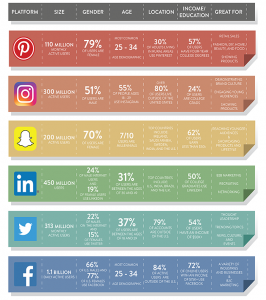Based on the Periodic Table of Marketing Attribution, this paid media molecule assembles elements from the attribution table into a molecular structure to visually demonstrates how attribution can build an effective revenue reporting system for paid media campaigns.
This molecular configuration shows the powerful complexities of touchpoint tracking, as well as the consequently impressive analysis that attribution brings to the table.
Eva Sharf, our paid media manager at Bizible, helped develop this graphic based on how she uses attribution to plan, configure, and optimize her digital advertising, paid search, and paid social campaigns.

Attribution can apply to all of B2B marketing, which is why the Periodic Table of Marketing Attribution is so extensive. There are 63 elements on the comprehensive periodic chart, and 26 of these elements (41% of the entire table) combine to form a visual representation of how attribution influences revenue reporting for the paid media marketing discipline.

The legend in the bottom-right corner of the campaign molecule corresponds to the Periodic Table of Marketing Attribution as well, and the colors designate which segment of the chart the elements came from.
Paid media relies heavily on ad networks, social networks, and paid search platforms (teal), and it utilizes a plethora of attribution-related capabilities (blue). Eva relies heavily on multi-touch attribution models (red), U-Shaped and W-Shaped, and she uses metrics such as “leads by web source” and “revenue by touchpoint” (green) to drive her optimizations.
The 26 elements included in the molecule are:
- Attribution
- Attribution Data
- Attribution Program
- Multi-touch
- U-Shaped
- W-Shaped
- Twitter
- AdWords
- LinkedIn
- Google Display Network
- Facebook
- Bing Ads
- Retargeting
- Landing page
- Campaign
- CRM
- API
- URL
- UTM
- Lead form
- Call-to-action
- Dashboard
- Touchpoint details
- Leads by web source
- Revenue by touchpoint
- Opportunities by channel
Connecting Marketing Channel Data to Attribution
You’ll notice that, from the “Landing Page” element in the top right segment (purple), there are two paths back to “Attribution Data” — one utilizes an API integration with Adwords and Bing Ads, and the other connects paid social campaigns through UTM parameters. These demonstrate the two optional methods of attribution tracking with various types of marketing campaigns.

Program-level integrations (i.e. API connections) allow data to pass seamlessly from one program to the other. UTM parameters are used to track website and URL activities through javascript tracking code on a website. Both of these methods meld together to create a comprehensive tracking system for all of your paid media marketing touchpoints, and all of this information is displayed inside the attribution program’s dashboard.

Attribution Modeling
Once all of the data has been tracked and gathered, an attribution solution can display that information in several different ways, depending on the attribution model your organization has chosen to use. Advanced, multi-touch attribution models are by far the most accurate models, because they disperse revenue credit for touchpoints more accurately. In this case, Eva tends to use both U-shaped (for lead reporting) and W-shaped (for everything else) modeling to evaluate her paid media campaigns.
Once the models have sorted the data, an advanced attribution program generates revenue-focused metrics that link the successes (and problems) to the specific marketing activities that are (or perhaps aren’t) impacting the bottom-line.

Based on the attribution model, specific touchpoints are assigned a revenue value. Those touchpoints can be tied back to the original web source that created those interactions, assigning revenue credit to that channel, campaign, and/or activity.
The attribution program can also sort opportunities based on the marketing channel that drove them, all within the organization’s CRM. Sales and marketing teams both have access to this transformative information, so both departments are able to make the most informed decisions possible.
Using attribution to track and optimize paid media can turn wasted spend into revenue contributions overnight. Eva uses these integrations, tracking methods, models, and metrics to create a surefire paid media machine that catches any wasted spend and reallocates it to campaigns that reliably generate leads, opportunities, and customers.
Digital & Social Articles on Business 2 Community
(154)






